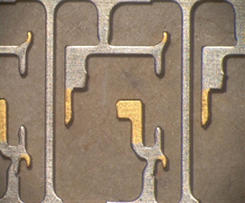Gold, which is beautifully distinctive, having excellent electrical conductivity, thermal conductivity, solderability, and other properties, plays an active part not only for decorative purposes but also as various types of functional plating for electronic devices and semiconductor parts as the only non-oxidizing metal.
| Type of plating | Features | Characteristic value |
|---|---|---|
| Acidic cyanogen bath | - Hardness and smoothness are enhanced by alloying trace amounts of cobalt or nickel. - Application to high-reliability solderable parts, such as connectors and semiconductors. - Strike plating from a strongly acidic bath is performed in the case of plating unplatable materials, such as stainless steel. |
Hv150 - 180 (for contacts); contact resistance 0.58 – 0.62mΩ |
| Neutral cyanogen bath | Applied for decorative purposes and to semiconductor-related parts requiring bonding. | Hv60~80 |
| Alkaline cyanogen bath | Decorative uses: necklaces, watches, eyeglass frames, lighting apparatus, etc. [1] Pink gold (Au-Cu alloy plating) [2] Green gold (Au-Ag alloy plating) [3] Green white gold (Au-Ni alloy plating) |
Hv200 – 270 (for decorative purposes) |
| Mildly alkaline non-cyanogen bath | For thin gold plating | |
| Electroless plating bath | Substitution type gold plating (primary nickel plating) |

Partial gold plating